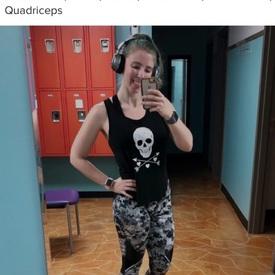BMR and TDEE Please help

vilyda123
Posts: 27 Member
I'm so confused about BMR and TDEE. How important are these numbers to weight loss? How does it affect CICO? Is there a reliable calculator? How often should I recalculate it? If it's important why doesn't mfp have a calculator?
0
Replies
-
BMR is what your body would burn just lying in bed all day. TDEE is what your body burns through basic functions (BMR, pretty much), daily activities (work, cleaning, taking care of the kids, shopping, socializing, driving) and exercise. As long as you're eating below your TDEE, you'll lose weight.
MFP doesn't run off TDEE. They use NEAT, which does not factor in exercise calories. This is why exercise gets added in separately and you eat those calories back. It's basically bringing you up to your TDEE.
scoobysworkshop.com has a very good TDEE calculator. You'll want to recalculate about every 5-10 pounds lost.0 -
I'm so confused about BMR and TDEE. How important are these numbers to weight loss? How does it affect CICO? Is there a reliable calculator? How often should I recalculate it? If it's important why doesn't mfp have a calculator?
Ok, from the top.
BMR - Basal Metabolic Rate - basically what your body needs to survive (calorie wise) just to stay alive, as if you were in a coma. It isn't really "need to know" but you do need it to figure your TDEE from if you are doing it manually. Many calculators will do if for you though. Some people use BMR as a guideline to not eat below.
MFP has a BMR calculator in the apps section.
TDEE - Total Daily Energy Expenditure - basically all the calories your body needs for the whole day. This includes BMR, plus your daily activity, like your job, brushing your teeth, walking to the car, plus exercise. Everything. If you eat at TDEE you should maintain your weight. If you want to lose weight, you need to eat below TDEE. There are many online calculators that can help you figure it. Bascially, it is your CO part of the CICO equation.
MFP does NOT calculate TDEE. What they do is figure your BMR, then add in your daily activity calories (when you select your daily activity level, this includes your job and other stuff but NOT exercise). Then MFP expects you to log additional exercise and eat those calories back.
The difference is with TDEE, your exercise is averaged over the week so you eat the same calories everyday. With MFP you only eat extra calories on the day you exercise so it can vary. Some people prefer the consistency of TDEE, others liek having some days with more calories. Plus it is good if you don't exercise regularly.
If you figure correctly both of these methods will put you in roughly the same spot when you average the calories over the week. It's a matter of preference.
0 -
first link will answer all your questions
http://www.iifym.com/tdee-calculator/
http://www.fat2fittools.com/tools/bmr/
http://www.fitnessfrog.com/calculators/tdee-calculator.html 0
0 -
MFP does have a BMR calculator. It's under apps.
MFP does not have a TDEE calculator, because it uses a different method for weight loss.
BMR = calories burned at complete rest. These are the estimated calories your body uses to keep your heart beating, you breathing, etc.
TDEE = calories to maintain your current weight. This is the number of calories you need to eat under to lose weight. TDEE includes BMR + daily activity + exercise (simple explanation, there is a bit more to it)
MFP estimates how many calories you burn before exercise. It uses your height, weight, and age to come up with your BMR. Then uses the BMR x a multiplier based on your activity level selection to come up with an estimated calorie burn before exercise. Your calorie goal is based off of this estimate and is why when you exercise calories get added into what you can consume for the day.
So the base goal on MFP is based on:
( BMR x activity level multiplier ) - selected deficit = calorie goal (minimum of 1200 for women/ 1500 for men regardless of selected deficit)
Then when you add exercise, your calorie goal increases and MFP shows this as Intake - Exercise = Calories consumed that weren't burned in exercise (you want this to be close to your base calorie goal)
If you want to eat a constant number of calories everyday, then TDEE method is recommended.
Scooby's Accurate Calorie Calculator is one (sorry don't have link at the moment)
Fat2Fit also has one
IFYM site also has one0 -
Thank you all very much! I was feeling a little lost. I really appreciate that you all to the time to respond.
0 -
I just did an IIFYM calculator and it told me I should be eating -7% carbs. lol Is this even possible?0
This discussion has been closed.
Categories
- All Categories
- 1.4M Health, Wellness and Goals
- 398.2K Introduce Yourself
- 44.7K Getting Started
- 261K Health and Weight Loss
- 176.4K Food and Nutrition
- 47.7K Recipes
- 233K Fitness and Exercise
- 462 Sleep, Mindfulness and Overall Wellness
- 6.5K Goal: Maintaining Weight
- 8.7K Goal: Gaining Weight and Body Building
- 153.5K Motivation and Support
- 8.4K Challenges
- 1.4K Debate Club
- 96.5K Chit-Chat
- 2.6K Fun and Games
- 4.7K MyFitnessPal Information
- 17 News and Announcements
- 21 MyFitnessPal Academy
- 1.5K Feature Suggestions and Ideas
- 3.2K MyFitnessPal Tech Support Questions




